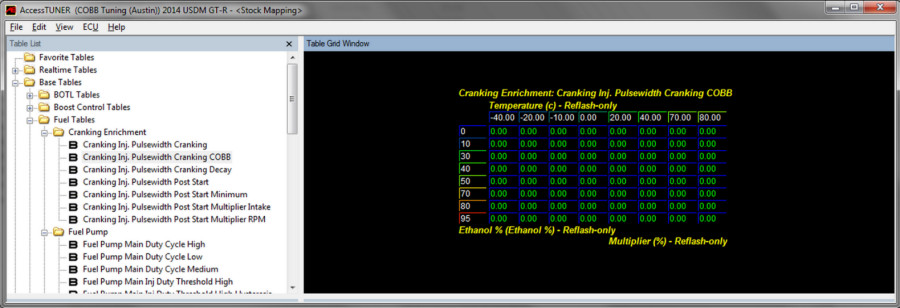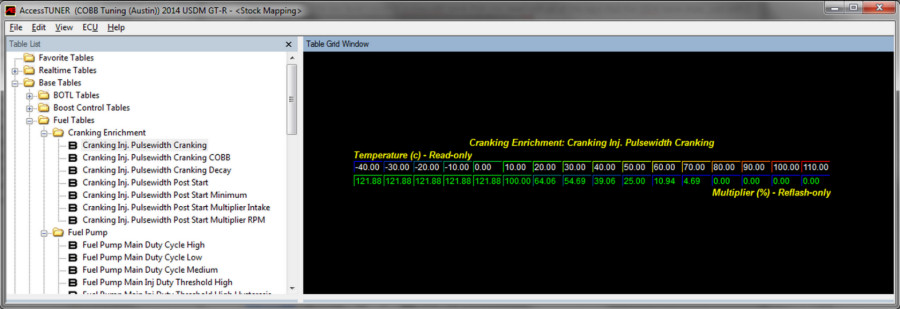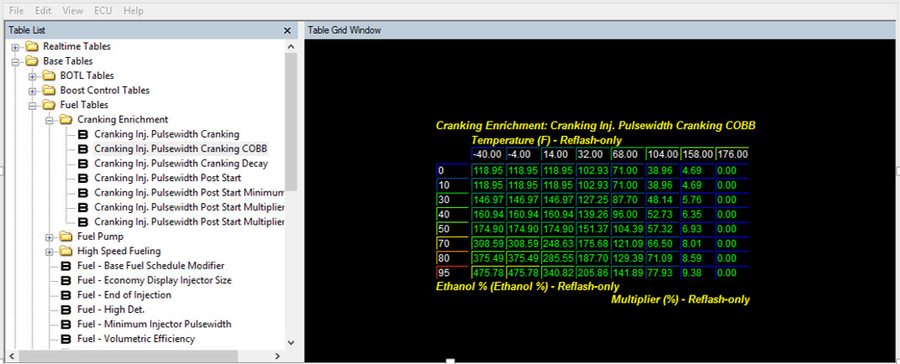Cobb Custom Features: GT-R Cranking Tables And Monitors
GT-R: Cranking and Post Start Fueling
4/25/2016
Cranking Tables
Accesstuner now has a new cranking pulsewidth multiplier table that utilizes OEM table strategy, but has a higher limit to the amount of fuel which can be added. It also has the benefit of being able to modify the cranking fuel by the ethanol content of the fuel. If no ethanol content sensor is installed, the table will default to the first column of the table which is the lowest ethanol content. When no ethanol content sensor is installed you may choose to populate all the ethanol values on the Y-axis with the same data to avoid confusion. The new table has a maximum value of 800% which is more than enough to get an ethanol using car started in even the coldest conditions
The new table is defaulted to all zeros causing the logic to be turned off by default. If you do not need to make any changes to the cranking fuel on the car, then no changes need to be made. If you do want to use the table, we advise that you populate the stock table with 0's so that the system is easier to modify and allow you to easily track tuning revisions.
Here is an example of transferring the stock values over to the new table, and also some preliminary scaling for different ethanol contents and temperatures. Your results may vary! After doing this you would populate the stock Cranking Inj. Pulsewidth Cranking table with all 0s.
The column to the furthest right must always be populated with a 0 in order for all the cranking systems to work correctly!
The Cranking Decay values work on both tables exactly the same as the OEM logic. In order to see the decay and the cranking fuel added with the new table you would log Crank Fuel Multiplier COBB.
Cranking Inj. Pulsewidth Post Start: This is the base table for fueling which has its own decay rate after the car switches from crank to run mode.
Cranking Inj. Pulsewidth Post Start Minimum: This table ensures that there is an absolute minimum fuel that will be added once the car switches from crank to run mode.
Cranking Inj. Pulsewidth Post Start Multiplier Intake: multiplier for post start fuel based on intake cam position. Not used in any oem calibration.
Cranking Inj. Pulsewidth Post Start Multiplier RPM: This is a multiplier for all post start fuel being applied. The fuel is trimmed vs RPM to help control how high the RPM flares during the post start event.
Cranking Fuel Operation:
The cranking fuel Multiplier (percentage) is made up of two components. The first is Cranking Inj. Pulsewidth Cranking (or Cranking Inj. Pulsewidth Cranking COBB) and Cranking Inj. Pulsewidth Post Start.
Crank Inj. Pulsewidth Cranking Decay is the rate at which the Cranking Base is reduced once the engine goes to the post crank state (at 1000 RPM). This will decay the Cranking Base to zero, the higher the number the faster the decay.
If the Post Start Component is less than Post Start Minimum then Post Start Component = Post Start Minimum
After the engine has exited cranking it will go into the post crank state. Then the Crank Fuel Cranking Base will be decayed by the Cranking Decay, this decay happens every ~10msec so it will decay quickly. The Crank Blend Down Multi is used elsewhere and decays at a slower rate of ~50m sec. The Blend Down reduces both values until the Crank Fuel Multi goes to zero.
The flex fuel table Cranking Inj. Pulsewidth Post Start (Flex Fuel) works exactly the same as the table in the base cranking folder. The blend rate table is used to blend between these two tables, the same as the other tables in the flex fuel folder, with 100% using the values directly from the table located in the flex fuel folder.
Cranking Monitors:
- Crank Blend Down Multi: Tracks the amount of fuel added for cranking and post start reduced at Crank Fuel Cranking Decay Rate (other math done for post start).
- Crank Fuel Cranking Base: Percentage of cranking fuel added during cranking, which is then decayed at a very fast rate in post start.
- Crank Fuel Cranking Decay Rate: Static value from the table based on start temperature which is used to decay the startup fuel.
- Crank Fuel Multi: Inclusive total percentage of fuel added from all cranking and post start tables.
- Crank Fuel Multiplier COBB: This is the current value from the COBB custom cranking fuel table which is then decayed at Crank Fuel Cranking Decay Rate when mode switches to post start.
- Crank Fuel Post Start Base: Current table value from Cranking Inj. Pulsewidth Post Start.
- Crank Fuel Post Start Engine Multi: Multiplier for all post start fuel being applied. The fuel can be trimmed to help with post start RPM flare.
- Crank Fuel Post Start Intake Multi: Multiplier for post start additive based on intake temperature.
Related content
Copyright 2025 © COBB Tuning Products LLC. All Rights Reserved. | www.cobbtuning.com









